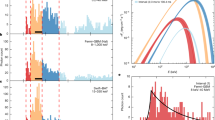Abstract
ALTHOUGH neutron stars are generally believed to be born with intense (1011–1013 G) magnetic fields1,2, which then gradually decay3, measurements of their field strengths remain uncertain. In the special case of X-ray-emitting binary pulsars, a direct estimate of the field strength can be obtained by measuring the energy of spectral features that are due to electron cyclotron resonance4–13. With the Ginga satellite observatory14,15, we have measured a cyclotron feature in the hard X-ray spectrum of the 1.24-s binary pulsar Hercules X–1 with a much greater energy resolution than in previous observations4–9. The spectrum from 10–60 keV can be described with a simple analytical formula12,16,17, which indicates an absorption feature at ∼34 keV rather than an emission feature at ∼50keV. From this we estimate the surface magnetic field strength of Her X–1 to be (2.9±0.3) × 1012 G.
This is a preview of subscription content, access via your institution
Access options
Subscribe to this journal
Receive 51 print issues and online access
$199.00 per year
only $3.90 per issue
Buy this article
- Purchase on Springer Link
- Instant access to full article PDF
Prices may be subject to local taxes which are calculated during checkout
Similar content being viewed by others
References
Manchester, R. N. & Taylor, J. H. Pulsars, 231–235 (Freeman, San Francisco, 1977).
Joss, P. C. & Rappaport, S. A. A. Rev. Astr. Astrophysics 22, 537–592 (1984).
Lyne, A. G., Manchester, R. N. & Taylor, J. H. Mon. Not. R. astr. Soc. 213, 613–639 (1985).
Trümper, J. et al. Astrophys. J. 219, L105–L110 (1978).
Voges, W. et al. Astrophys. J. 263, 803–813 (1982).
Coe, M. J., Engel, A. R., Quenby, J. J. & Dyer, C. S. Nature 268, 508–509 (1977).
Soong, Y., Gruber, D., Peterson, L. & Rothschild, R. Astrophys. J. 348, 641–646 (1990).
Tueller, J. et al. Astrophys. J. 279, 177–183 (1984).
Staubert, R. et al. Space Sci. Rev. 30, 311–323 (1981).
Wheaton, W. et al. Nature 282, 240–243 (1979).
White, N. E., Swank, J. H. & Holt, S. S. Astrophys. J. 270, 711–734 (1983).
Clark, G. W., Woo, J. W., Nagase, F., Makishima, K. & Sakao, T. Astrophys. J. 353, 274–280 (1990).
Nagase, F. Publs astr. Soc. Japan 41, 1–79 (1989).
Makino, F. et al. Astrophys. Lett. & Comm. 25, 223–233 (1987).
Turner, M. J. L. et al. Publs astr. Soc. Japan 41, 345–372 (1989).
Tanaka, Y. in Radiation hydrodynamics in Stars and Compact Objects (eds Mihalas, D. & Winkler, K. H.), 198–221 (Springer, Berlin, 1986).
Makishima, K. et al. Publs astr. Soc. Japan 42, 295–315 (1990).
Pravdo, S. H. et al. Astrophys. J. 225, 988–993 (1978).
Bonazzola, S., Heyvaerts, J. & Puget, J. L. Astr. Astrophys. 78, 53–64 (1979).
Mészáros, P. & Nagel, W. Astrophys. J. 298, 147–160 (1985).
Wang, J., Wasserman, I. & Salpeter, E. Astrophys. J. 338, 343–358 (1989).
Herold, H. Phys. Rev. D19, 2868–2875 (1979).
Wang, J. C. L. et al. Phys. Rev. Lett. 63, 1550–1553 (1989).
Tananbaum, H. et al. Astrophys. J. 174, L143–L149 (1972).
Trümper, J., Kahabka, P., Ögelman, H., Pietsch, W. & Voges, W. Astrophys. J. 300, L63–L67 (1986).
Murakami, T. et al. Nature 335, 234–235 (1988).
Author information
Authors and Affiliations
Rights and permissions
About this article
Cite this article
Mihara, T., Makishima, K., Ohashi, T. et al. New observations of the cyclotron absorption feature in Hercules X–1. Nature 346, 250–252 (1990). https://doi.org/10.1038/346250a0
Received:
Accepted:
Issue Date:
DOI: https://doi.org/10.1038/346250a0
This article is cited by
-
Expulsion of magnetic flux lines from the growing superconducting core of a magnetised quark star
Astrophysics and Space Science (2008)
-
Magnetized quark and strange quark matter in the spherical symmetric space–time admitting conformal motion
General Relativity and Gravitation (2007)
-
Magnetic absorption lines in stellar spectra
Astrophysics and Space Science (1994)
-
Radiation-driven diskons: An overview
Space Science Reviews (1994)
Comments
By submitting a comment you agree to abide by our Terms and Community Guidelines. If you find something abusive or that does not comply with our terms or guidelines please flag it as inappropriate.



